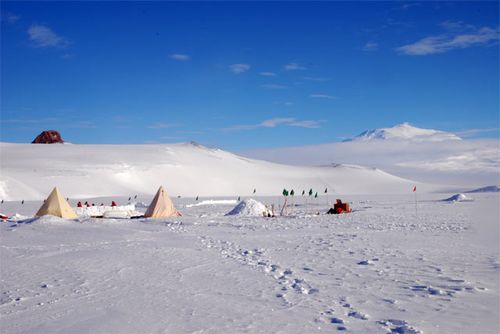Answer to Yesterday’s WATIZIT
Congratulations to Mike for his correct quess that we are wearing buckets to simulate being in a whiteout and trying to find someone else who is lost.
 Whiteout Rescue Training
Whiteout Rescue Training
Whiteout Rescue Training
Today’s WATIZIT Picture
<figure class="standalone-image" style="display:block; width:500px;"><img src="/files/members/kirk-beckendorf/images/watizit001.jpg" alt="WATIZIT" title="WATIZIT" width="500" height="335" /><figcaption class="caption" style="display:block">WATIZIT</figcaption>
What kind of animal is this skull from? (Hint- this picture was inspired by a question from Maren Nelsen's students).
When we crawled out of our tents, snow trenches and quinzees in the morning, the wind and snow had stopped, the sky was clear and the white featureless area was replaced by a scene of immense mountains jutting up from the flat sea ice. Steam was rising from Mt Erebus, the nearest mountain, which is an active volcano.
 Camp and Mt Erebus
Camp and Mt Erebus
In the kitchen.
 Camp
Camp
Camp, Castle Rock and Mt Erebus
Danny had told us the night before to have camp packed up and ready to "fly out” by 9:00AM. Part of this training is for us to learn how to live in a remote field camp. So if a pilot is scheduled to pick up the camp at 9:00AM everything had better be ready to go when the plane or helicopter gets there.
 Camp has been broken down
Camp has been broken down
Quinzee and Mt. Erebus
After a relatively leisurely morning, we started breaking down camp. Promptly at 9:00 our "pilot” arrived in the form of Danny on a snowmobile. We packed our gear onto the sled and headed for a small hut nearby where we had breakfast and Danny continued our instruction.
We spent the rest of the afternoon learning three main topics. First we practiced using two different kinds of radios and how to communicate from the field or in an emergency. We used one to actually talk to someone who was at the South Pole.
Listen to part of our conversation by clicking on the file below.
 Setting up HF radio
Setting up HF radio
Setting up HF Radio
Then we learned how to rescue someone who is lost during a storm. Storms here can be extremely severe. When the wind is blowing very hard picking up loads of snow, a person may not be able to see more than 4-5 feet away. The wind can be so loud that you may not be able to hear much further away than that. If someone is lost in those kind of conditions finding them can be extremely dangerous for the rescuers. So Danny had us practice finding someone who is lost under those conditions.
 Whiteout rescue training
Whiteout rescue training
Whiteout Rescue Training
After that we all loaded onto a pretend airplane and had a pretend crash. Those of us who "survived” the crash had to design a plan for how to deal with the situation. Occasionally Danny would throw us a curve ball, such as having someone lose their gloves or someone becoming hypothermic.
After the two days we were no longer the individuals and strangers that had been when we boarded the Delta the day before, we have become much more of a team who worked together.
 First Class of 2008
First Class of 2008
First Class of 2008

